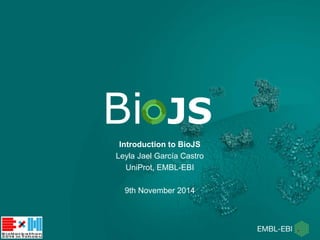Bio js2 short_introduction
- 1. Bi JS Introduction to BioJS Leyla Jael GarcÃa Castro UniProt, EMBL-EBI 9th November 2014
- 2. Bi JS Components Application EMBL-EBI Motivation Discoverability, modularity and reuse Unify efforts, collaborate, avoid duplication
- 3. EMBL-EBI Bi JS BioJS at a glance A collection of JavaScript components following a common guideline to visually present biological What When âĒ Jan 2014 â F1000 collection âĒ May/Aug 2014 â Google Summer of Code âĒ July 2014 â BioJS 2.0 release âĒ Aug 2011 â Student project âĒ Dec 2012 â BioJS 1.0 at EBI âĒ Feb 2013 â AppNote in Bioinformatics Community of developers and collaborators Who Development: https://github.com/biojs/biojs Learning: http://edu.biojs.net/ General information: http://biojs.net/ Where
- 4. EMBL-EBI From BioJS 1.0 to 2.0 Bi JS âĒ BioJS 1.0 â Fixed core ï Inheritance and event model â Built process with jsdoc + maven ï not working for everybody â Not compatible with common module and dependency management tools âĒ BioJS 2.0 â No core but guidelines + event module â Better support for module and dependency management â Developers are free to use their preferred technologies
- 5. EMBL-EBI Bi JS Development Guidelines âĒ Make it simple ï one thing at a time âĒ Use modules ï separate retrieval, process, visualization âĒ Document ï code and examples âĒ Make it open ï GitHub âĒ Share ï publish your modules as a Node Packaged Module
- 6. EMBL-EBI Bi JS Development Technology âĒ Highly recommended âĒ Module management âĒ Module dependency âĒ Dependency management ï commonJS, require.js âĒ Test suits ï choose your preferred one and use it! âĒ Either JavaScript or transpilers
- 7. EMBL-EBI Bi JS Development Community âĒ Participate ï biojs google groups âĒ Share ï submit your modules to BioJS registry
- 8. EMBL-EBI BioJS at GSoC Bi JS âĒ GSoC is a program designed to â Encourage students participation in open source software development. â Inspire young developers to begin participating in open source development â Get more open source code created and released for the benefit of all âĒ What does it mean for BioJS? â Ideal way to explore potential new ideas or bring ideas into production â Getting more people involved â First participation 2014 âĒ 5 successful projects ï Genetic variations, proteome taxonomy, BAM file, MSA, phylogenetic tree âĒ BioJS 2.0 initiative 8
- 9. EMBL-EBI âĒ Links across datasets ï VoID linksets â Gray A., Jupp S., Malone J. Competency driven linksets of convenience â From an ENSEMBL protein, which entities in other datasets can I reach? âĒ Path finder across multiple datasets â Improve idea â Path finder algorithm â Visualization draft
- 10. Thanks to: BioJS project members and collaborators EBI RDF Project










